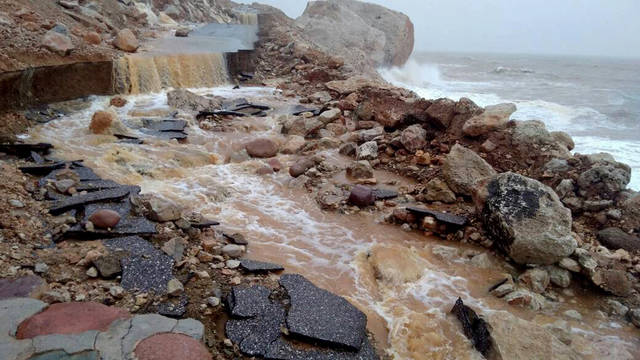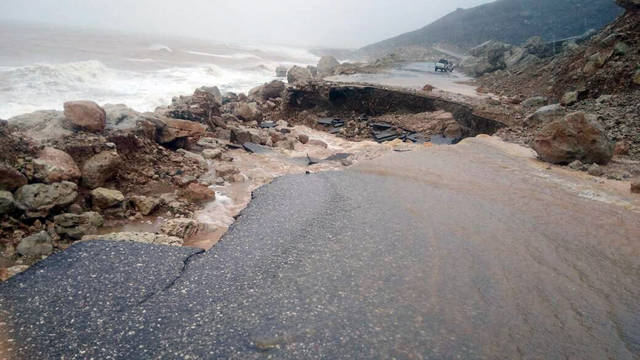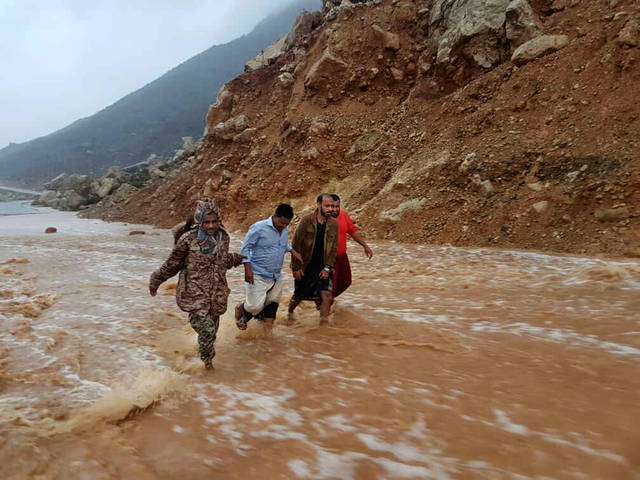SALALAH, Oman — Cyclone Mekunu pounded the Yemeni island of Socotra in the Arabian Sea on Thursday morning, lashing it with heavy rain and strong winds as the powerful storm remained on a path to strike Oman this weekend. At least 17 people were reported missing.
With winds now gusting up to 160 kph (100 mph), meteorologists expected the “very severe” cyclone to strike Oman on Saturday near Salalah, the sultanate’s third-largest city and home to some 200,000 people near the country’s border with Yemen.
“It is very likely to intensify further during next 24 hours,” India’s Meteorological Department warned in a bulletin Thursday. It said gusts from the storm will likely reach 190 kph (118 mph) by Saturday.
Yemen’s pro-government SABA news agency reported that 17 people were missing after two ships capsized in the storm and three vehicles washed away. It said Yemen’s government, exiled in Saudi Arabia, had declared Socotra a “disaster” zone after the storm.
Images circulated online from Socotra show soaking wet residents attempting to find shelter from the storm. The photos and video footage, which went viral Thursday, show strong winds with rain, flash flooding and mudslides.
Mohammed al-Arqabi, a resident of the island who works as a local journalist, described the situation as “very bad,” saying “the water level has greatly increased, and floods are everywhere … washing away cars.”
“More than 200 families have been displaced from their homes in the suburbs of Hadibu and areas close to the northern coast,” he said. “Two Indian cargo ships have gone missing, losing five of their crew members.”
Rajeh Bady, a spokesman for the exiled government, said the island was in need of “urgent” aid, according to SABA.
The island, listed by UNESCO as a world natural heritage site, has been the focus of a dispute between the United Arab Emirates and Yemen’s internationally recognized government amid that country’s war after Shiite rebels, known as Houthis, seized the Yemeni capital, Sanaa.
Saudi troops recently deployed on Socotra as a confidence-building measure over complaints by Yemen’s government that the UAE deployed troops there without its permission.
Socotra has a unique ecosystem and is home to rare species of plants, land snail and reptile species that can be found nowhere else around the planet. It is known for its flower-and-fruit-bearing dragon blood tree, which resembles an umbrella and gets its name from the dark red sap it secretes. Socotra hosts endangered species of land and sea birds and its waters hold hundreds of distinctive species of reef-building corals and fish.
A cyclone is the same as a hurricane or a typhoon; their names only change because of their location. Hurricanes are spawned east of the international date line. Typhoons develop west of the line. They are known as cyclones in the Indian Ocean and Australia.
Seasonal rains are nothing unusual for southern Oman this time of year. While the rest of the Arabian Peninsula bakes in areas where temperatures near 50 degrees Celsius (122 degrees Fahrenheit), those in the sleepy port city of Salalah enjoy rainy weather that sees fog and cool air at wrap around its lush mountainsides. Temperatures drop down around 25 degrees Celsius (77 degrees Fahrenheit) during its annual monsoon festival.
Powerful cyclones, however, are rare. Over a roughly 100-year period ending in 1996, only 17 recorded cyclones struck Oman. In 2007, Cyclone Gonu tore through the sultanate and later even reached Iran, causing $4 billion in damage in Oman alone and killing over 70 people across the Mideast.
The last hurricane-strength storm to strike within 100 miles (160 kilometers) of Salalah came in May 1959, according to the U.S. National Oceanic and Atmospheric Administration’s archives. However, that cyclone was categorized as a Category 1 hurricane, meaning it only had winds of up to 95 mph (152 kph). Mekunu, which means “mullet” in Dhivehi, the language spoken in the Maldives, is on track to potentially be as powerful as a Category 3 hurricane.
Ahead of the storm, Omani media reported lines at gas stations in Salalah, the hometown of Oman’s longtime ruler, Sultan Qaboos bin Said. The Royal Oman Police urged citizens to seek safety and warned that floods were likely in valleys. It also said it planned to deploy more ambulances and police officers to areas likely to be affected by the cyclone.
Also, the Health Ministry said it evacuated critically ill patients at locations of the Sultan Qaboos Hospital in Salalah, flying them by air north to Muscat, the country’s capital. State television aired images of others being evacuated from remote villages in the path of the cyclone.
The port of Salalah, crucial to Qatar amid a boycott by four Arab nations over a diplomatic spat with Doha, said it also had taken precautions and secured cranes ahead of the cyclone.
———
Associated Press writers Menna Zaki and Maggie Michael in Cairo contributed to this report.
———
Follow Jon Gambrell on Twitter at https://twitter.com/jongambrellAP . His work can be found at http://apne.ws/2galNpz .




